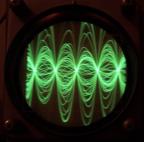Strength through Synchrony
 Our connection to the external world occurs only through the thalamus, through which all sensory signals (except olfaction) must pass in order to gain access to the neocortex. As Alonso points out in his editorial on Bruno & Sakman's 2005 Science paper, our sensory systems are incredibly sensitive - many observers can detect a single photon in complete darkness, and we'll notice an indentation on our skin of as little as 20 microns (this is about 3 times the diameter of a single red blood cell).
Our connection to the external world occurs only through the thalamus, through which all sensory signals (except olfaction) must pass in order to gain access to the neocortex. As Alonso points out in his editorial on Bruno & Sakman's 2005 Science paper, our sensory systems are incredibly sensitive - many observers can detect a single photon in complete darkness, and we'll notice an indentation on our skin of as little as 20 microns (this is about 3 times the diameter of a single red blood cell).And yet, the neural connections between thalamus and the cortex are incredibly weak both in terms of the strength of their signal (.5 mV, 30 times smaller than average intracortical connections) and in terms of the prevalence of synapses ("thalamocortical synapses account for less than 15% of all synapses onto L4 spiny neurons" in the cortex, according to Bruno & Sakman). So how do we maintain such sensitivity in the absence of any substantial neural signals?
One theory holds that signals from the thalamus are amplified by recurrent connections in cortex. Another theory suggests that thalamic signals don't need a "cortical amplifier" to evoke an action potential in cortex, but that they merely need to synchronize their firing to take L4 neurons over threshold. Bruno & Sakman found evidence that this may be the exact mechanism by which thalamocortical connections evoke action potentials in L4: sensory stimulation, but not sinusoid electrical stimulation to the thalamus, evoked "synchronous discharge of thalamic neurons."
Further analyses showed that as little as 30 thalamic cells firing synchronously could suffice to evoke action potentials in cortex. Therefore, the authors argued that a cortical amplifier in L4 is unnecessary to account for how cortex is capable of receiving inputs from thalamus, and thus, how we are able to perceive the outside world.


6 Comments:
the brain fascinates me
I love to explore the various levels of the mind through abstract art and extrasensory data really intrigues me
this must have something to do with your theories images that we notice in another time and space
you may have no answer, but i actually have, at least at this point, "sensory" multiple sclerosis. how can i take this new knowledge you have shared about the thalamus into consideration when looking at my illness changes, which i know involve myelin loss.
Hi Molly - I'm sorry. I'm really not familiar with multiple sclerosis. However, you might try the Myomancy blog, which has many articles and blog postings on cognitive and developmental disorders.
you may have no answer for me, but i have what they call "sensory" multiple sclerosis (at least at this point), lots of skin numbness/oversensitization, painful flashes, warming and cooling sensations- how can i in coroporate what you have just shared about the thalamus, knowing that ms involves myelin loss, when considering my illness, mri/cat results etc..
interesting blog
The brain might only be connected to the world physically on paper through the Thalamus and yes it is amazing but something are just beyound current science. We are self aware, that is something which isn't physical and can't really be defined or explained by biology in order to be self aware you must acknowledge a world beyound yourself. When you can explain thought, then you'll have an answer to you question.
So, smell isn't routed through the bottleneck.... interesting.
Post a Comment
<< Home